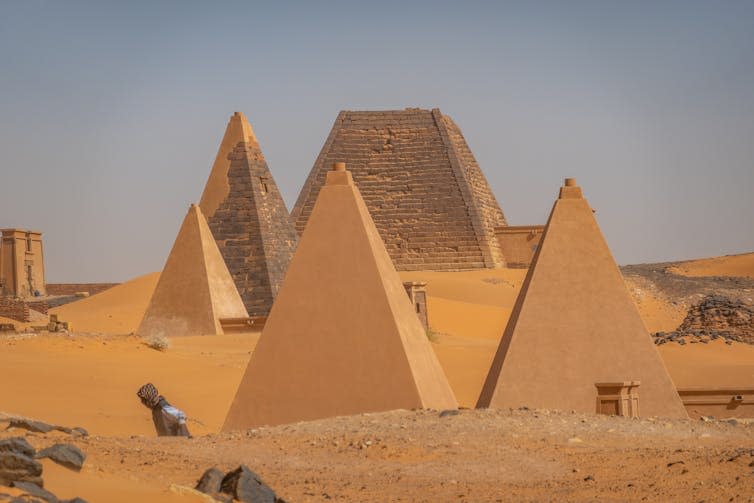Just Stop Oil drew needed attention to climate-threatened Stonehenge

Two Just Stop Oil activists recently sprayed powder paint on parts of Stonehenge, the 5,000 year old monuments in southern England. The paints will wash away with the rain, the campaigners claimed. But at least one archaeologist thinks the stones will have a harder time surviving the longer droughts and more intense rains of the near future.
The action predictably prompted outraged responses from the likes of UK prime minister Rishi Sunak (a “disgraceful act of vandalism”) and the man likely to replace him, Keir Starmer (“Just Stop Oil are pathetic”). In the days that followed, it was hard to find a supportive voice in the British media.
Just as predictably, that same media largely ignored a peaceful 50,000-strong “Restore Nature Now” march through London just a few days later.

This roundup of The Conversation’s climate coverage comes from our weekly climate action newsletter. Every Wednesday, The Conversation’s environment editor writes Imagine, a short email that goes a little deeper into just one climate issue. Join the 30,000+ readers who’ve subscribed.
The Conversation has previously looked at how a single radical action gets more media coverage than thousands of marchers and its implications for political and climate protest. And we’ve also looked at how even widely-hated activism can ultimately be successful: a cognitive psychologist who researches political protest told us that people may want to shoot the messenger, but they do hear the message.
Sarah Kerr, an archaeologist at University College Cork, says there’s something specific about heritage sites like Stonehenge that generated “an almost desperate desire for rigid preservation”.
But she notes that “Stonehenge and its landscape are dynamic features that forever shift and change.”
They have been beset by wars, roadworks and countless solstice gatherings. The stones were touched by thousands of hands before a barrier was installed and still bear the footfall of millions of visitors. They have withstood several interventions by archaeologists, who have hoisted the stones upright and replaced the lintels. In fact, all of the stones painted by Just Stop Oil – 21, 22 and 23 – have been re-erected or consolidated during the 20th century.
The stones have been defaced and graffitied before and will survive Just Stop Oil. For Kerr, the bigger threat to Stonehenge is climate change itself.
Read more: Stonehenge protest: if you worry about damage to British heritage you should listen to Just Stop Oil
We don’t have specific climate projections for the stone monuments, but we can look just a short distance west to the site of Glastonbury, the UK’s largest music festival, which begins today.
Richard Betts is a climate scientist at the University of Exeter and was one of the lead authors of the UK’s official climate change risk assessment. A few years ago he gave a talk at the festival on climate science and how Glastonbury might have to cope with several degrees of global warming.
He pointed out that exactly what global average changes mean for south-west England specifically are hard to pin down, but that:
climate models tend to project milder, wetter winters, and hotter, drier summers (although some models suggest summers will be slightly wetter). But even if summers do become drier overall, when it does rain we can expect more intense downpours, as already happens in hotter climates elsewhere in the world. Therefore we can expect increased flooding risk in both winter and summer.
This is bad news for 5,000-year old stones nearby. Kerr says this additional extreme weather will “exacerbate erosion of the faces of the stones caused by freezing and thawing, while much wetter or much drier soil undermines their stability”.
Stonehenge isn’t the only ancient site at risk from climate change. Archaeologists Gillian Taylor and Rosie Everett of Teesside and Northumbria Universities have written about how climate change is washing away precious evidence of our distant past.
They are particularly concerned with peat, which keeps wood, leather and textiles well-preserved. However climate change, and particularly the heavy, localised rains it is associated with, is “washing away layers of soil and peat to reveal archaeological buildings, items and human remains”.
They cite the well-preserved Roman forts of Magna and Vindolanda, near Hadrian’s Wall in northern England.
Here, archaeologists have discovered the first evidence of handwriting by a woman (Claudia Severa writing to invite her friend Sulpicia Lepidina to her upcoming birthday party), the world’s oldest boxing gloves from around AD120, and the largest Roman leather shoe collection ever found – consisting of an astonishing 7,000 items.
All these discoveries and more were encased in peat, which means they’re also threatened by climate-driven deterioration. They “fear that finds which haven’t yet been discovered may soon be irreversibly damaged”.
Read more: How climate change is washing away precious evidence of our distant past
There are plenty of examples from elsewhere in the world too. For instance, the world’s largest collection of ancient pyramids is found not, in Egypt, but in neighbouring Sudan, where more than 200 steep-sided structures poke sharply out of the sand and reveal the wealth and power of the Nubian civilisation.
However, these pyramids risk being buried by shifting sand dunes. Ahmed Mutasim Abdalla Mahmoud, then of the University of Nottingham, says the problem itself is nothing new: there is evidence of Kushite kings clearing sand away from pyramids more than two millennia ago.
“But today”, he writes, “the threat has been exacerbated by climate change, which has made the land more arid and sandstorms more frequent”.
There’s one potential upside: some archaeologists believe sand movement helps to preserve ancient artefacts from thieves. But Mahmoud says sand is “detrimental to excavated sites, reburying them beneath the desert”, while sand blown by the wind also “erodes delicate stonework and sculptures”.
Read more: Sudan's 'forgotten' pyramids risk being buried by shifting sand dunes
If you hadn’t even heard of these pyramids (and I hadn’t before I worked on that article), it’s perhaps a nice example of a problem identified by Kerr, the Stonhenge archaeologist:
While Just Stop Oil’s protest at Stonehenge has generated outrage, there is silence over the cumulative and ongoing effects of climate change upon this and other heritage sites. There is little to no public uproar about climate change posing one of the biggest challenges to cultural landscapes, buried archaeology and the built environment.
This article is republished from The Conversation under a Creative Commons license. Read the original article.


 Yahoo News
Yahoo News 


